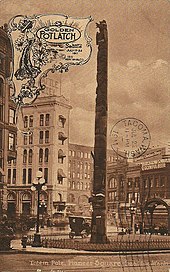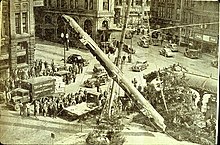Seattle totem pole
The Seattle Totem Pole , and Pioneer Square Totem Pole called, stands at Pioneer Square , Seattle in the US state of Washington . Together with the Pioneer Building erected in 1892 and the iron pergola erected in 1909, it is one of the National Historic Landmarks in Washington State. The totem pole located there today is a reproduction made in 1939/1940 of the totem pole erected here in 1899, which had been stolen from a Tlingit village on Tongass Island a few weeks earlier .
The original totem pole was erected around 1870 in honor of a member of the Raven clan within the Tlingit people. The animal symbols shown represent three stories of the raven clan.
Story of theft
In September 1899, a group of Seattle businessmen and artists toured the Alaska Panhandle aboard the City of Seattle steamship . The trip was sponsored by the Seattle Post-Intelligencer newspaper and was designed to explore business opportunities between Alaska and Seattle. During a stop at Fort Tongass on Tongass Island, RD McGillvery, one of the sailors of the steamship, went ashore. He later reported:
“The Indians were all gone fishing - except for one who stayed at his house and looked scared to death. We picked the best looking totem pole ... I took a couple of sailors ashore and we felled it - just like you would cut a tree. It was too big to roll onto the beach, so we sawed it in two. "
For his efforts, the expedition members paid McGillvrey US $ 2.50.
The expedition members donated the totem pole to the city of Seattle, where it was erected on October 18, 1899, the anniversary of the Alaska Purchase in Pioneer Square. During the celebration of the erection of the totem pole, representatives of the city of Seattle praised the merchants for their foresight and prophesied that the totem pole would become a symbol of Seattle's greatness. One of the speakers also assured the assembled crowd that the totem pole had no owner and that the merchants had intervened to save it from certain destruction. If he had not fallen victim to the zeal of missionaries, he would certainly have been a victim of fire.
David E. Kininnook, a member of the Tlingit clan who owned the stolen totem pole, reached out to John Green Brady , the governor of Alaska, and requested either the return of the totem pole or payment of $ 20,000. The art historian Aldona Jonaitis points out that the sum requested was by no means excessive. The erection of totem poles was associated with the alignment of a potlatch , in which the position of the organizing family in the hierarchy of the respective tribe was confirmed. Part of the potlatch was the generous handing over of gifts to the festival participants. By accepting the gift, they confirmed the host family's claim to the coat of arms depicted on the totem pole and their social position. Due to the fur trade along the coastal waters of British Columbia and Alaska, the gifts presented had a high monetary value.
David E. Kininnook's complaint ultimately resulted in a grand jury in Alaska finding that eight of the prominent expedition members had stolen "government property". The designation of the totem pole as government property is due to the fact that the Tlingit village was under the jurisdiction of Fort Tongass, a U.S. military facility. However, Seattle Attorney William H. Thompson contested that the totem pole had been stolen.
“The village has long been deserted. Here [in Seattle] the totem pole will tell of the actions of the natives in a clearer language than when it lies between moss and fern on the coast of Tongass Island. "
The conviction by a grand jury from Alaska was ultimately inconsequential. Representatives and senators from all states bordering the Pacific coast campaigned, inter alia, at the State Court in Washington, DC , for the judgment to be overturned. However, they remained unsuccessful in Washington, DC. James William Clise, one of the participants in the 1899 expedition and long time chairman of the Seattle Chamber of Commerce, wrote in his 1935 memoir that it was ultimately direct action on a newly appointed judge of the United States District Court in Alaska who made sure that the execution of the judgment was suspended. This judge made a stopover in Seattle on his journey and was so hospitable by both Clise and other prominent Seattle residents that one of the judge's first acts in Alaska was to suspend the sentence. In 1909, when Seattle was hosting the Alaska-Yukon-Pacific Exposition, the stolen totem pole graced the official brochure.
Destruction and creation of the totem pole
In 1938, an arsonist set the totem pole on fire in Pioneer Square, causing irreparable damage. Since there were no skilled craftsmen in Seattle, city officials decided to have the remains brought to Ketchikan to rebuild the totem pole. In Ketchikan, the Civilian Conservation Corps ran a project that employed members of the Tlingit and Haida people to restore or reproduce old totem poles from nearby villages. Charles Braun, a member of the Tlingit people, led the team that carried out the reproduction of the Seattle totem pole. On July 24, 1940, the totem pole was rebuilt in Pioneer Square.
meaning
The anthropologist John R. Swanton wrote one of the first scientific articles on the Seattle totem pole in 1905 for The Journal of American Folklore. He noted, among other things, that the totem pole belonged to the Tlingit family Hunt, which was one of the most important families in the Tlingits and belonged to the raven clan. In 1990 Robin K. Wright dealt with the origin and meaning in more detail.
The Seattle totem pole was erected around 1870 in honor of Mary Ebbets Hunt's mother. The stories that are presented on the totem pole have come down to us about her son Georg Hunt. It is relatively rare that the stories associated with the totem pole are known. As a rule, only those who have been informed by the sculptor or the client what a totem pole should represent can “read” the message that the representations symbolize. If the totem pole was made for two different families, an animal depiction on two different totem poles depicts different beings or tells a different story in each case. If the stories are not passed on, the meaning of the totem pole cannot be interpreted. Then only the animal figures can be interpreted, but the connection can no longer be deciphered.
The top of the totem pole is a raven with the moon in its beak. The figure symbolizes the story according to which the raven stole the sun, moon and stars from a rich man who kept them hidden in a box. Below the raven is a woman with a frog. The two represent the story of a woman from the Raven clan who teased a frog and was then carried to his village by the frog. She married him and had two frog children. She escaped by sending her two sons to her father's house to get a bone for skin piercing. Her sons persuaded their father to break a dam so that the lake in which the frog village was located ran out. All the frogs except the two frog children died. The figures at the bottom of the totem pole refer to other stories of the Raven clan. Depicted are mink, raven and a whale with its head down. At the bottom is the chief of all birds. The raven once took the mink with him as his companion and they were swallowed by a whale that carried them across the water. The whale allowed them to cut pieces of its whale fat to eat. However, he asked her to avoid his heart. The whale landed on Haida Gwaii , where people cut a hole in the skin to allow the mink and raven to escape. The mink emerged from the hole covered with oil and rolled around in rotting wood, which is what gives its fur its appearance to this day. The raven did the same. The raven and mink wandered around Haida Gwaii and came to a large house. In it lived a man with a bird's beak who was the chief of all birds. The raven regarded himself as the chief of all ravens, and this displeased the chief of all birds. He turned the raven back into one of the common ravens as we know them today.
During the 19th century, it had become common practice among the indigenous peoples of the northwest coast of North America to reproduce totem poles. This happened when, for example, settlements were abandoned or family members married and moved to other villages. For this reason there was a reproduction of the Seattle totem pole early on. It had been commissioned by David Hunt, a grandson of Mary Ebbets Hunt, and stood outside his home in Fort Rupert, British Columbia. This totem pole was made by Charlie James in the style of the Kwakwaka'wakw , but he uses the same animal symbols.
literature
- Aldona Jonaitis: Discovering Totem Poles . University of Washington Press, Seattle 2012, ISBN 978-0-295-99187-0
Web links
- History of the Seattle Totempole on History Link
- National Registar of Historic Place website
- Report of the theft of the totem pole
- Robin K. Wright: Totem Poles: Heraldic Columns of the Northwest Coast
Single receipts
- ↑ History of the Seattle Totempole on History Link , accessed November 7, 2013.
- ↑ Aldona Jonaitis: Discovering Totem Poles . University of Washington Press, Seattle 2012, ISBN 978-0-295-99187-0 , p. 4
- ↑ a b c Aldona Jonaitis: Discovering Totem Poles . University of Washington Press, Seattle 2012, ISBN 978-0-295-99187-0 , p. 5
- ↑ a b c Report on the theft of the totem pole , accessed November 7, 2013.
- ↑ a b c Robin K. Wright: Totem Poles: Heraldic Columns of the Northwest Coast, accessed November 7, 2013
- ↑ Aldona Jonaitis: Discovering Totem Poles . University of Washington Press, Seattle 2012, ISBN 978-0-295-99187-0 , p. X
Coordinates: 47 ° 36 '8.4 " N , 122 ° 20' 2.3" W.




